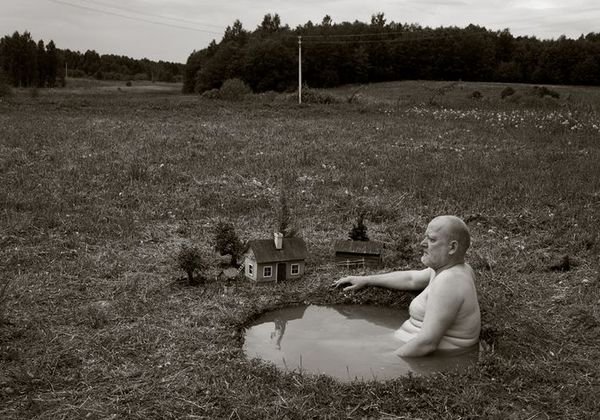Algis Griskevicius
dal 22/1/2009 al 22/2/2009
Segnalato da
22/1/2009
Algis Griskevicius
Giedre Bartelt Galerie, Berlin
Signs. Some of his photographs reflect what some people refer to with respect and others with scorn as high culture. This is a concept of the past, and it is from there that the artist draws popular images that have almost become cliches, and immediately merges them with the plebeian present.

Algis Griskevic(ius (*1954) is best known as a painter who
occasionally creates sculptures. However, photography has always
existed in his paintings. Not just because they look faithfull to
reality (although the imitative nature of his paintings is a
disguise), not just because they often give an impression of
accidental snapshots, but mainly because the artist has used
photography as a way of sketching and memorising impressions since
the 1980s. What is painted has been photographed beforehand. But
photography is necessary not only to help the memory. It has become
instrumental in the artist's relationship with reality.
The content of his photographs is not social. You will not learn
anything about the hard lives of the poor, or find an answer to the
riddle of the meaning of life. It is not erotic, although the
pictures teem with naked bodies, or political (but, who knows, maybe
these nudes might be past or future politicians?). Neither is it
documentary (what is pictured is not reality) or intended to
impress. In fact, these photographs are just short ironic stories.
Some of his photographs reflect what some people refer to with
respect and others with scorn as "high culture". This is a concept
of the past, and it is from there that the artist draws popular
images that have almost become clichés, and immediately merges them
with the plebeian present.
The artist construes images that do not bring you closer to any
noble experience or beautiful ideas but rather move you away from
them. He clearly does not let the viewer in, but remains in the
safety of irony. The artificiality of the situation and the
exaggerated materiality of the props create absurdity and art are
all absurd.
A practically amateurish, only greatly oversized, photograph is one
more layer commenting on a situation, not only showing the absence
of criteria for professionalism and the presence of complete
permissiveness but also enhancing the feeling of absurdity. A
stranger to photography, the artist intrudes into a foreign sphere,
destroying its canons, which he does with partial seriousness,
seeking not to cause a revolution but only to have fun.
The object of most photographs, a middle-aged, large and balding
(usually the same) man is the antithesis of "normal" photography
which feeds on nice young ladies with additional retouching. Skin
free of wrinkles, spots and cellulite is the most common object in
photography. In Gris(kevic(ius' photographs bright daylight shows
the body in an everyday pose. Therefore, it looks unnatural when
naked (equally unnaturally pink), just as in everyday life people do
not usually walk around undressed.
Thus, those rough, real and unnatural bodies combine into signs of
the Zodiac, a fountain or a swing, and try to become symbols.
As a photographer, Gris(kevic(ius is a director. With the exception
of a few "domestic" observations, everything is a performance.
The photographs show a drama about everyday concepts, ghosts of the
past and even, so to speak, the artist's calling. I have a suspicion
that the photograph called "the Director" depicts the artist himself.
Agne Narusyte, photo historian
Opening on Friday, January 23th 7-9 p.m.
Giedre Bartelt Galerie
Linienstrasse 161 - Berlin
Free admission



